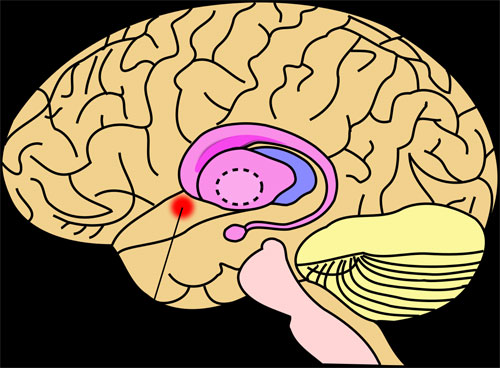The Lenticular Nucleus: The Center for Learning and Motivation
The lenticular nucleus works in conjunction with other structures of the basal ganglia. Its connections have a lot to do with acquiring and improving skills.

Our nervous system is full of curiosities, and the lenticular nucleus is one of them. It’s a subcortical brain structure that, among other things, is the source of motivation and learning. However, when we talk about the lenticular nucleus, we aren’t referring to a specific structure, but rather to a set of them.
In this article, we’ll show you the parts, characteristics, and functions associated with this nucleus. In addition, we’ll show you the most common problems and their consequences. Finally, we’ll also share a few curiosities with you. Let’s get started!
What are the different parts of the lenticular nucleus?
First of all, it owes its name to its lens shape. We can find it below the insula, and it has three segments that are mainly divided into two structures, according to the book Neuroscience: Exploring the Brain, written by Bears, Connors, and Paradiso. These are the two structures:
Putamen. Its shape is circular and it’s the most external of the nuclei. It connects with the substantia nigra and the globus pallidus, which enables the passing of information between the basal ganglia, cerebral cortex, and thalamus.
Globus pallidus. Also known as paleostriatum, it divides into two parts: external (or lateral) and internal (or medial). It receives information from the striatum and projects the thalamus and cerebral cortex through it. It has internal and external segments.
Therefore, we can say that the lenticular nucleus is the union of two structures. It’s made up of gray matter, is cuneiform, and is attached to the internal and external capsules. In it, we can find, above all, the GABA neurotransmitter, acetylcholine, and the encephaline peptide.
Now, besides the lenticular nucleus, what are the other parts of the basal ganglia?
– Striatum
– Substantia nigra
– Caudate nucleus
– Nucleus accumbens
– Subthalamic nucleus
These nodes are a set of interconnected nuclei located around the limbic system and third ventricle. Their functions include planning, integration, movement control, learning, and motivation. Remember that, even though there are anatomical divisions in each part of the brain, it doesn’t participate in just one single function.
Functions of the lenticular nucleus
It has many varied functions. Here are the main ones:
Motivation. It integrates information, thus linking knowledge and stimuli. Isn’t that amazing?
Learning. It mainly provides procedural learning. In addition, it intervenes in the categorization process, which facilitates the organization of information. It also participates in the acquisition and improvement of skills.
Movements. It has to do with the automation of movements, since it intervenes in different processes, such as adaptation. In addition, it also plays a role in keeping our posture and controlling our movement coordination. Finally, the putamen deals with muscle movement in our face and extremities.
To carry out these functions, the lenticular nucleus establishes connections with the cerebral cortex and thalamic nuclei. This communication can be bi-directional.
Disorders
This nucleus can be linked to subcortical dementias. For example, those produced by Parkinson’s disease and Huntington’s disease. These are associated with the inability or difficulty to coordinate and carry out movements, accompanied by a deficit in executive functions and memory.
There’s also a link to psychomotor disorders. One example of this is, again, Parkinson’s disease, since the basal ganglia are affected. It also has to do with other movement disorders, such as ataxia, Gilles de la Tourette syndrome, and nervous tics.
This nucleus is also at the center of some mental disorders, such as obsessive-compulsive disorder. This occurs when both the caudate nucleus and the putamen are overactivated. In addition, the abnormal functioning of the lenticular nucleus also seems to have an influence in attention-deficit/hyperactivity disorder, as it interferes with motivation and learning, and favors the appearance of tics.
In short, the lenticular nucleus is essential. We’ve seen that it’s responsible for many different and varied functions, such as motor skills or attention. In addition to this, it also helps us to become more organized and structured with how we store and recall information. Thus, it enhances our learning. However, when something goes wrong, it can directly affect our well-being, and, with it, our quality of life.
yogaesoteric
June 24, 2020
